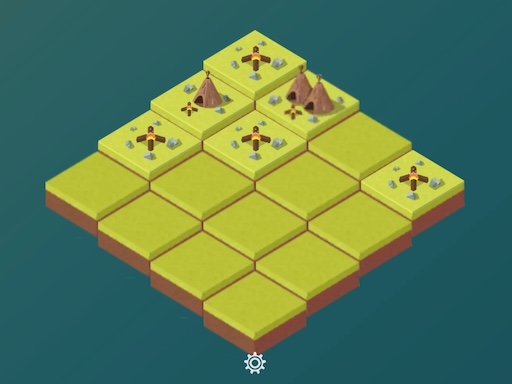Virtual Sculpture Puzzle
About Virtual Sculpture Puzzle
You know how sometimes you stumble across a game, almost by accident, and it just… clicks? Like, it’s not even something you knew you were looking for, but the moment you experience it, you realize it’s been this missing piece in your gaming life all along? Well, I’ve had that exact sensation recently, and honestly, I *have* to tell you about it. It’s called Virtual Sculpture Puzzle, and I swear, it’s going to redefine what you think a puzzle game can be.
I’ve always been drawn to games that engage your brain in a unique way, something beyond just quick reflexes or button mashing. I love a good mystery, a clever environmental puzzle, or even the meditative quality of a well-designed crafting system. But this… this is different. Imagine taking the sheer, unadulterated satisfaction of a classic jigsaw puzzle – that feeling of a perfectly cut piece slotting into place, the way the image slowly reveals itself – and then, and this is where it gets wild, you lift it off the table and into the third dimension. Seriously.
The first time I launched it, I wasn’t entirely sure what to expect. The menu was clean, elegant, and then I saw the first puzzle. It wasn’t a flat picture, not at all. It was a shimmering, almost ethereal collection of disconnected shards, floating in a serene, almost cosmic void. My initial thought was, "Okay, so it's a 3D jigsaw. Cool, I guess." But that's like saying a gourmet meal is "cool, I guess" because it's just food. It’s so much more.
What immediately grabbed me was the visual fidelity. The game’s description talks about "beautiful and realistic 3D graphic," and I mean, they weren't kidding. These aren't just polygonal shapes; they’re rendered with such exquisite detail, such incredible lighting, that you can almost feel the texture of the material. One of the early puzzles I tackled was this ancient-looking, ornate golden mask. Each fragment gleamed, catching the ambient light, and you could see the tiny imperfections, the subtle tarnishing that gave it a sense of history. Another one was a futuristic, chrome-plated spacecraft, and the way the light reflected off its polished surfaces was just mesmerizing. You can almost feel the cool, smooth metal under your fingertips as you manipulate the pieces.
The brilliant thing about this is how it transforms the very act of puzzling. In a traditional jigsaw, you’re looking at flat edges, matching colors and patterns. Here, you’re dealing with *volume*. You pick up a piece, and you can rotate it freely in three-dimensional space. You’re not just matching a flat side; you’re trying to find the perfect curve, the precise angle, the exact protrusion or indentation that will seamlessly merge with another piece. It’s like being a digital sculptor, slowly chiseling away at chaos to reveal the hidden form within.
There’s something magical about that moment when you’ve got a piece floating there, and you’re turning it, turning it, and then suddenly, you see it. That specific notch, that particular angle, that unique contour that just *has* to fit. You guide it over, and with a satisfying, almost tactile *thunk*, it locks into place. And it’s not just a flat connection; it’s a deep, structural bond. The sculpture grows, gaining solidity, gaining definition, and you feel this incredible rush of accomplishment. It’s that same feeling you get when a strategy finally clicks into place in an RTS, or when you nail a perfect combo in a fighting game – that moment of pure, unadulterated understanding and execution.
What I love about games like this is how they demand a different kind of focus. You’ll find yourself zooming in, rotating the entire nascent sculpture to get a better angle, looking at it from above, from below, from every conceivable side. Sometimes, a piece that looked utterly alien from one perspective suddenly makes perfect sense when viewed from another. It’s a constant dance between micro and macro, between individual fragments and the grand design. You start to develop this almost intuitive spatial reasoning, seeing not just the pieces, but the negative space, the gaps that need filling.
The game isn't just about assembling a single, static object either. The variety of sculptures is genuinely impressive. I’ve worked on everything from intricate clockwork mechanisms where you can almost hear the gears whirring, to delicate, crystalline structures that look like they’ve been plucked from an alien garden. Each one presents its own unique challenge, its own visual language. A biological form might have organic, flowing curves, while a mechanical one will have sharp, precise angles and repeating patterns. It keeps things fresh, constantly pushing you to adapt your approach.
And the difficulty scales beautifully. You start with simpler, more recognizable forms, maybe with fewer pieces. But then, it ramps up. You get sculptures with hundreds of fragments, some so tiny and intricately detailed that they feel like microscopic components. The real magic happens when you're faced with a particularly complex one, where you've got dozens of pieces that all look vaguely similar, and you're just meticulously, patiently, trying every permutation. There are moments of genuine frustration, I won't lie. You'll be staring at a section, convinced you've tried every possible piece, every rotation, and nothing fits. Your shoulders might even tense up a bit. But that's what makes the victory so much sweeter. When that one stubborn piece finally, *finally* slots in, it’s not just a sigh of relief; it’s a triumphant roar in your head.
It’s also incredibly meditative. I mean, I’ve lost track of time so many evenings just getting absorbed in this. The serene, ambient soundtrack gently hums in the background, never intrusive, always supportive of the focused atmosphere. It’s the kind of game you can put on after a long, stressful day and just… unwind. Your mind clears, the outside world fades, and it’s just you, the floating fragments, and the satisfaction of creation. It’s a digital zen garden, but instead of raking sand, you’re building breathtaking art.
In my experience, the best moments come when you’re nearing completion. You’ve done the bulk of the work, and the sculpture is mostly formed, but there are still these tantalizing gaps. You can almost see the finished product, almost touch it, but it’s not quite there. And then you find that last, elusive piece. You rotate it, guide it home, and with that final *click*, the sculpture is whole. The game often gives you a little flourish, a subtle animation, a soft glow as the completed object settles, and you get this panoramic view of your creation. It’s genuinely breathtaking. You feel like an artisan, a master craftsman, having brought something beautiful into existence.
This isn't just a game; it’s an experience in patience, spatial awareness, and the sheer joy of discovery. It’s about taking something fragmented and making it whole again. It’s about appreciating beauty in detail, and understanding how small parts contribute to a magnificent whole. If you’re anything like me, and you appreciate games that challenge your mind while also offering a deeply satisfying, almost therapeutic experience, then you absolutely, positively *need* to check out Virtual Sculpture Puzzle. Trust me, you’ll be thanking me later. It’s a discovery I can’t stop talking about, and I honestly think it’s one of those hidden gems that everyone deserves to experience. Just wait until you encounter that first truly massive, intricate sculpture – the feeling of bringing that to life is just… incredible. You can almost feel your heart rate increase with anticipation as you search for that last, perfect piece. It’s pure gaming bliss.
I’ve always been drawn to games that engage your brain in a unique way, something beyond just quick reflexes or button mashing. I love a good mystery, a clever environmental puzzle, or even the meditative quality of a well-designed crafting system. But this… this is different. Imagine taking the sheer, unadulterated satisfaction of a classic jigsaw puzzle – that feeling of a perfectly cut piece slotting into place, the way the image slowly reveals itself – and then, and this is where it gets wild, you lift it off the table and into the third dimension. Seriously.
The first time I launched it, I wasn’t entirely sure what to expect. The menu was clean, elegant, and then I saw the first puzzle. It wasn’t a flat picture, not at all. It was a shimmering, almost ethereal collection of disconnected shards, floating in a serene, almost cosmic void. My initial thought was, "Okay, so it's a 3D jigsaw. Cool, I guess." But that's like saying a gourmet meal is "cool, I guess" because it's just food. It’s so much more.
What immediately grabbed me was the visual fidelity. The game’s description talks about "beautiful and realistic 3D graphic," and I mean, they weren't kidding. These aren't just polygonal shapes; they’re rendered with such exquisite detail, such incredible lighting, that you can almost feel the texture of the material. One of the early puzzles I tackled was this ancient-looking, ornate golden mask. Each fragment gleamed, catching the ambient light, and you could see the tiny imperfections, the subtle tarnishing that gave it a sense of history. Another one was a futuristic, chrome-plated spacecraft, and the way the light reflected off its polished surfaces was just mesmerizing. You can almost feel the cool, smooth metal under your fingertips as you manipulate the pieces.
The brilliant thing about this is how it transforms the very act of puzzling. In a traditional jigsaw, you’re looking at flat edges, matching colors and patterns. Here, you’re dealing with *volume*. You pick up a piece, and you can rotate it freely in three-dimensional space. You’re not just matching a flat side; you’re trying to find the perfect curve, the precise angle, the exact protrusion or indentation that will seamlessly merge with another piece. It’s like being a digital sculptor, slowly chiseling away at chaos to reveal the hidden form within.
There’s something magical about that moment when you’ve got a piece floating there, and you’re turning it, turning it, and then suddenly, you see it. That specific notch, that particular angle, that unique contour that just *has* to fit. You guide it over, and with a satisfying, almost tactile *thunk*, it locks into place. And it’s not just a flat connection; it’s a deep, structural bond. The sculpture grows, gaining solidity, gaining definition, and you feel this incredible rush of accomplishment. It’s that same feeling you get when a strategy finally clicks into place in an RTS, or when you nail a perfect combo in a fighting game – that moment of pure, unadulterated understanding and execution.
What I love about games like this is how they demand a different kind of focus. You’ll find yourself zooming in, rotating the entire nascent sculpture to get a better angle, looking at it from above, from below, from every conceivable side. Sometimes, a piece that looked utterly alien from one perspective suddenly makes perfect sense when viewed from another. It’s a constant dance between micro and macro, between individual fragments and the grand design. You start to develop this almost intuitive spatial reasoning, seeing not just the pieces, but the negative space, the gaps that need filling.
The game isn't just about assembling a single, static object either. The variety of sculptures is genuinely impressive. I’ve worked on everything from intricate clockwork mechanisms where you can almost hear the gears whirring, to delicate, crystalline structures that look like they’ve been plucked from an alien garden. Each one presents its own unique challenge, its own visual language. A biological form might have organic, flowing curves, while a mechanical one will have sharp, precise angles and repeating patterns. It keeps things fresh, constantly pushing you to adapt your approach.
And the difficulty scales beautifully. You start with simpler, more recognizable forms, maybe with fewer pieces. But then, it ramps up. You get sculptures with hundreds of fragments, some so tiny and intricately detailed that they feel like microscopic components. The real magic happens when you're faced with a particularly complex one, where you've got dozens of pieces that all look vaguely similar, and you're just meticulously, patiently, trying every permutation. There are moments of genuine frustration, I won't lie. You'll be staring at a section, convinced you've tried every possible piece, every rotation, and nothing fits. Your shoulders might even tense up a bit. But that's what makes the victory so much sweeter. When that one stubborn piece finally, *finally* slots in, it’s not just a sigh of relief; it’s a triumphant roar in your head.
It’s also incredibly meditative. I mean, I’ve lost track of time so many evenings just getting absorbed in this. The serene, ambient soundtrack gently hums in the background, never intrusive, always supportive of the focused atmosphere. It’s the kind of game you can put on after a long, stressful day and just… unwind. Your mind clears, the outside world fades, and it’s just you, the floating fragments, and the satisfaction of creation. It’s a digital zen garden, but instead of raking sand, you’re building breathtaking art.
In my experience, the best moments come when you’re nearing completion. You’ve done the bulk of the work, and the sculpture is mostly formed, but there are still these tantalizing gaps. You can almost see the finished product, almost touch it, but it’s not quite there. And then you find that last, elusive piece. You rotate it, guide it home, and with that final *click*, the sculpture is whole. The game often gives you a little flourish, a subtle animation, a soft glow as the completed object settles, and you get this panoramic view of your creation. It’s genuinely breathtaking. You feel like an artisan, a master craftsman, having brought something beautiful into existence.
This isn't just a game; it’s an experience in patience, spatial awareness, and the sheer joy of discovery. It’s about taking something fragmented and making it whole again. It’s about appreciating beauty in detail, and understanding how small parts contribute to a magnificent whole. If you’re anything like me, and you appreciate games that challenge your mind while also offering a deeply satisfying, almost therapeutic experience, then you absolutely, positively *need* to check out Virtual Sculpture Puzzle. Trust me, you’ll be thanking me later. It’s a discovery I can’t stop talking about, and I honestly think it’s one of those hidden gems that everyone deserves to experience. Just wait until you encounter that first truly massive, intricate sculpture – the feeling of bringing that to life is just… incredible. You can almost feel your heart rate increase with anticipation as you search for that last, perfect piece. It’s pure gaming bliss.
Enjoy playing Virtual Sculpture Puzzle online for free on Qotori games. This Puzzle game offers amazing gameplay and stunning graphics. No downloads required, play directly in your browser!
How to Play
Mouse click or tap to play





Comments
This game is awesome! I love the graphics and gameplay.
One of the best games I've played recently. Highly recommended!